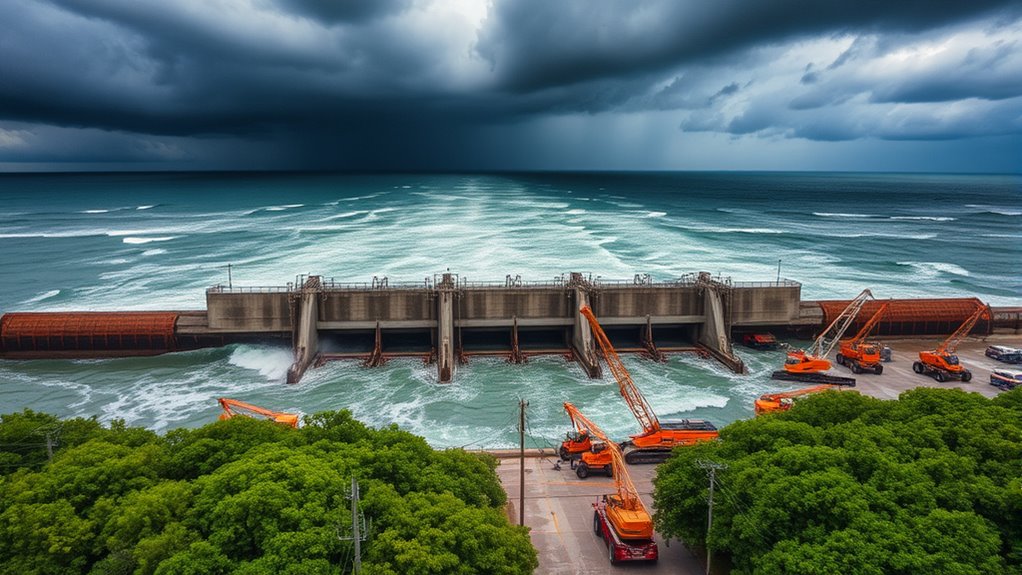Storm surge defenses in Gulf Coast ports have been reinforced to combat the severe threats posed by hurricanes. Structures like seawalls and the Bolivar Roads Gate System are fundamental for managing high surge waters. These measures not only protect important industries but also enhance community resilience. As climate change exacerbates coastal risks, investments in storm surge defenses are critical. If you want to learn more about these initiatives and their impact, there are further details available.
Key Takeaways
- Coastal Texas Project enhances storm surge defenses in Gulf Coast ports through significant infrastructure improvements and investments.
- The Bolivar Roads Gate System is a critical barrier that protects ports from storm surge impacts.
- Seawalls and storm surge barriers are essential structural defenses for Gulf Coast ports, mitigating flooding risks.
- Community engagement and education initiatives prepare residents and port workers for potential storm surge emergencies.
- Collaborative funding from federal, state, and local agencies ensures the sustainability of storm surge defense projects.

Storm surge poses a significant threat to Gulf Coast ports, with historical data revealing it accounts for about 90% of hurricane-related fatalities. When hurricane winds push seawater ashore, extreme flooding occurs, endangering lives and disrupting local economies. As climate change and rising sea levels intensify, coastal communities face heightened risks. The National Oceanic and Atmospheric Administration predicts sea levels along the Gulf Coast could rise by up to 4 feet by 2100, making storm surge preparedness more essential than ever.
To combat these risks, the Galveston Bay Storm Surge Barrier System is being developed. This project aims to enhance coastal resilience and reduce storm surge impacts on Galveston Bay and its surrounding areas. A key component is the Bolivar Roads Gate System, a 2-mile-long structure that effectively manages storm surge, safeguarding crucial industries from flooding. By integrating structural defenses with ecosystem restoration efforts, this system not only protects but also supports long-term sustainability, guaranteeing that local economies can thrive even in the face of natural disasters.
Various storm surge defenses are important for maintaining safety in vulnerable areas. Seawalls act as the first line of defense against high surge waters, while storm surge barriers can be constructed to block or redirect floodwaters during severe weather. Temporary dams offer flexible responses to protect at-risk locations, and beach nourishment fortifies shorelines with additional sand to absorb wave energy, reducing the overall impact of surge events. Additionally, ecosystem restoration of marshes and wetlands enhances natural defenses and promotes biodiversity.
Investment in coastal resilience is imperative. Initiatives like the Coastal Texas Project aim to improve infrastructure and storm surge defenses, with federal, state, and local agencies collaborating to finance and implement these projects. The estimated investment in storm surge defenses is expected to exceed hundreds of millions of dollars over the next decade. Public-private partnerships are increasingly leveraged to enhance resources and expertise, guaranteeing that coastal projects are effective and sustainable.
Community engagement and education play essential roles in preparedness. Awareness programs inform residents about storm surge risks and effective preparedness measures. Local governments can encourage citizen involvement in planning processes for storm surge defenses, and emergency response drills prepare communities for potential evacuations. By fostering a culture of preparedness, you can help guarantee your community is ready to face storm surge threats, ultimately protecting lives and livelihoods along the Gulf Coast.
Frequently Asked Questions
How Do Storm Surges Impact Shipping Routes in the Gulf Coast?
Storm surges greatly impact shipping routes in the Gulf Coast.
You’ll notice vessels rerouting due to increased water levels and flooding, leading to longer travel times and higher costs.
Access to inland waterways can become complicated, disrupting navigation for barges and cargo ships.
As delays accumulate, they create ripple effects throughout the supply chain, ultimately affecting delivery times and driving up prices for consumers.
You’ll want to stay updated on weather forecasts to mitigate these risks.
What Are the Costs Associated With Reinforcing Storm Surge Defenses?
Reinforcing storm surge defenses can feel like a financial tightrope. On one hand, you’re investing in safety; on the other, the costs can soar.
You might face an estimated $34.4 billion, potentially rising to $57 billion with inflation. While federal funding covers 65%, local entities bear the rest, putting a strain on taxpayers.
Balancing immediate needs against long-term benefits will be essential as you navigate this complex financial landscape.
How Often Are Storm Surge Defenses Evaluated for Effectiveness?
You’ll find that storm surge defenses are evaluated regularly to guarantee their effectiveness.
Typically, assessments happen after significant storms, while routine inspections occur every few years.
Thorough evaluations, incorporating new data and technologies, take place every 5 to 10 years.
Climate change has increased the need for more frequent evaluations, as rising sea levels and changing weather patterns require adaptive management strategies to keep communities safe from storm surge risks.
What Role Do Local Communities Play in Storm Surge Defense Planning?
Local communities play an essential role in storm surge defense planning, like artists shaping a canvas.
You gather feedback, ensuring the designs reflect specific needs and concerns. By integrating ecosystem restoration and promoting public awareness, you foster community buy-in.
Your involvement also highlights the economic benefits, protecting local industries. Together, you develop resilience strategies that combine structural and non-structural measures, creating an all-encompassing defense that resonates with both people and the environment.
Are There Federal Funds Available for Storm Surge Defense Projects?
Yes, there are federal funds available for storm surge defense projects.
The Army Civil Works Program allocates money for preliminary work, while significant federal contributions are essential for larger projects.
However, funding challenges exist, and projects often depend on sustained funding commitments over time.
You should be aware that these funds can be affected by environmental regulations and project complexity, which may impact construction timelines and overall project success.
Conclusion
As the Gulf Coast ports bolster their storm surge defenses, you’re witnessing a powerful fortress rising against nature’s fury. These enhancements aren’t just steel and concrete; they’re lifelines for communities and economies alike. By investing in resilience, you’re ensuring that when the next storm brews, the ports stand tall and ready, much like a lighthouse guiding ships safely through a tempest. Your support in these efforts can make all the difference in weathering future storms.










